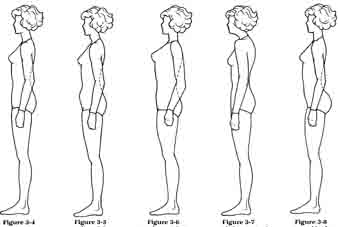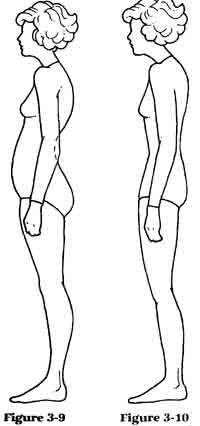Posture refers to the alignment of the body parts and to the manner in which
the body frame is carried. It has a direct bearing on both physical and mental
health.
Posture can communicate an individual’s self-image, personality, moods, and attitudes. It can influence physical attractiveness and the attractiveness
of clothing.
Incorrect posture can introduce needless figure variations and fitting problems.
Often improved posture—coupled with a weight change when needed—can eliminate
many or all figure variations discovered in the evaluation of a figure.
Therefore,
evaluating posture is worthwhile even before becoming involved with fitting.
You can best evaluate your posture in front of a full-length, three-way mirror or with the aid of a photograph. Assume a normal, relaxed, but controlled stance; don't attempt to assume a corrected posture. (For an accurate evaluation, a realistic stance is required.) Stand without shoes; high heels affect body alignment by shifting the center of balance.
Your weight should be evenly distributed on both feet, from front to back and from side to side. A plumb line, a weighted string that hangs perpendicular to the floor, can be used to evaluate body alignment. Hang the line from the top of the mirror or draw it on the photograph. The edge of a door can also function as a plumb line. When viewing the body profile the line should extend from the ear to the floor. On the standard figure it will bisect the ear, neck, shoulder joint, and elbow, pass just to the back of the wrist, bisect the hip joint and knee, and finally pass in front of the ankle (see Figure 3-4).
Moving from the head downward, proper body alignment requires the following:
• The head and neck are centered over the shoulders, with the chin parallel to the floor
• The shoulders are pulled slightly back and down
• The chest is slightly lifted
• Buttock muscles are contracted slightly and tucked under, both sides parallel to the floor
• Abdominal muscles are taut
• The arms hang relaxed at the sides, the elbows bent slightly forward
• The knees are straight but relaxed, neither flexed (bent) nor hyperex tended (locked)
• The feet are parallel and somewhat apart, with toes pointing straight ahead and the ankles joining the feet at right angles
Incorrect alignment causes the body to counterbalance itself in order to remain erect. Overly erect posture can be recognized by an exaggerated lift of the chest, which in turn creates an arch in the upper back (see Figure 3-6). The head may also be pulled back to an extreme, which will cause the plumb line to pass in front of the ear. The knees are often hyper-extended to the back and locked into place. Such a stance places stress on the back and legs. A prominent bust, shortened upper back length, and an increased chest length from neck base to bust tip may result. Other possible results are squared shoulders, widened chest, and a narrowed back. The position of the shoulders is particularly important in fitting, as clothing hangs from the shoulders. If shoulders are incorrectly positioned, all garment areas below will drape or fit incorrectly.
Rounded back posture can be recognized by an overly curved upper back, a forward curve in the shoulders, a hollow chest, and a forward-tilted head (see Figure 3-7). The plumb line will pass behind the ear. Breathing may be hampered because of pressure on the lungs; the oxygen supply to the body will be reduced, and chronic fatigue may result. Among the figure variations introduced may be found a shortened—possibly hollow and narrowed—chest length, increased upper back length and width, and prominent neck cords.
A swayed back will be evident by the forward tilt of the pelvis; a prominent abdomen and protruding buttocks result (see Figure 3-8). The abdominal curvature also will increase, as will the angle at the groin. Other probable figure variations include a shortened upper back length between waist and hip, and an increased length of buttocks to crotch.

Figure 3-4 to 3-8 Correct posture; Protruding abdomen; Overly erect back;
Rounded upper back and shoulders, forward head; Swayed back/ Forward pelvic
tilt
A slumped posture is common; it results in a rounded upper back and shoulders, hollow chest, and forward head, in combination with a swayed back and prominent abdomen (see Figure 3-9). In addition to all the other figure variations that result from poor posture, it also may lead to the accumulation of excess weight at the base of the neck, commonly referred to as a dowager’s hump. Slumped posture typically results in fatigue and backache, with discomfort increasing in the event of pregnancy. (A short-term counterbalance effect can be expected during pregnancy; as the bust and the abdominal area extends, the shoulders become overly erect and the arch in the back is increased.)

Fig. 3-9 Slumped posture; Fig 3-10 Rounded
shoulders, forward head and backward pelvic tilt
Rounded shoulders, a forward head and backward pelvic tilt is an uncommon postural variation. It is characterized by rounded back posture as previously discussed, in combination with an awkward tilt of the pelvis that pulls the waist area back and thrusts the hip joint and thigh forward. The buttocks are tucked under and knees may appear in a slightly bent position. The front abdominal curve will increase and buttocks curve will decrease. The individual appears to lead with the hips when walking. (See Figure 3-10.)
If no other means are available to evaluate your posture, you may resort to the use of a wall. Assume a normal stance with your back against the wall; your weight should be evenly distributed over both feet. Your body alignment is good if your shoulders, shoulder blades, and buttocks touch the wall. The space between the wall and the small of your back should be just large enough to insert a flat hand.
If only the shoulders touch the wall, your posture is overly erect. If only ‘our shoulder blades touch the wall, you have rounded posture. If only your buttocks touch the wall, you have a swayed back. (An exception to this would be the individual with large buttocks.) If both shoulder blades and buttocks touch the wall and there is a large space between your waist and the wall, you probably have slumped posture.
If poor posture is prolonged, the stress and strain on muscles, bones, and joints will contribute to fatigue and health problems common in later years. However, poor posture can be corrected, if the individual is committed to the effort required. Try the following posture exercises:
• Assume corrected posture while aligned against a wall; maintain this posture and walk away from the wall
• Stop and hold correct posture for a short period of time
• Force a mental image of correct posture while walking; practice often
• Evaluate your posture often, in front of a mirror or as you pass a window
• Practice good posture while walking, sitting, or bending
The time used in improving poor posture is time well spent. It can improve your health and reduce or eliminate figure variations, fitting problems and pattern or garment alterations that result.
